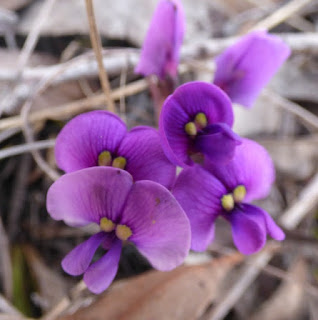Mainly North Mulligans Flat
Before getting to the many delights of North Mulligans Flat here are a couple of updateish photographs from our block.
I finally managed to find a few flowers of Hardenbergia violacea. Perhaps this wet year will get it back to its former lurid presence?
I have mentioned that the Glossodia major is beginning to flower. Today, for the first time this season, I noticed a lot of buds appearing as well as an increase in the number of open flowers.
The rather phallic looking object is a bud - the camera focussed on the flower behind it.
So off we went to Mullies, where we had been told of many Diuris chryseopsis. They will come in a few lines but first I will note the area was quite damp. This dam seemed quite full.
So did this one until I noticed the tide line and realised it was still about 2.5m below full. How much rain does it take to fill it?
Here is an impressionistic snap of a clump of the D. chyseopsis (aka Golden Moth orchid).
Here is a close up.
The only other orchid we found today was Caladenia (again) fuscatus (aka Petalochilus fuscatus).
This is included to show the variability of the colour of this species: the structure does I think show them to be the same species.
This little pink jobbie had us puzzled a little until I was able to see white petals with a purple ring. That made it a relatively Late Nancy - which is still Wurmbea dioica.
There was a mass of heaths around. Here is a mid-range snap of a bush of Leucopogon fletcheri.
This is a longer view of many bushes on a hillside.
Also a heath is Lissanthe strigosa (Peach Heath).
Traditionally Melichrus urceolatus (Urn Heath) is the first of the heaths to flower, after being in bud for most of Winter
As well as the yellow orchids there were lots of Craspedia variabilis (Billy Buttons) some of which were decorated with beetles ....
and some of which were not yet ready for arthrodic invasion. This does look like an interesting set of whorls there - does our friend the Fibonnaci Series come in to play again?
Ranunculus sp.
Hibbertia sp.
Compared to what is going on in Carwoola the beans were getting their act into gear. This was the first Bossiaea buxifolia we found.
Probably Daviesia genistifolia. Because the flowers are quite small, and dark, they are not spectacular when glanced at but become interesting when scrutinised.
Given the number of kangaroos around there was a surprising amount of Indigofera australis around.
As we were heading back to the car Frances noticed this large Bearded Dragon on the path.
In case you wondered why they are called 'Bearded' the next couple of images should assist your understanding!
Something to do with 'spiny' could be added to their name.
I finally managed to find a few flowers of Hardenbergia violacea. Perhaps this wet year will get it back to its former lurid presence?
I have mentioned that the Glossodia major is beginning to flower. Today, for the first time this season, I noticed a lot of buds appearing as well as an increase in the number of open flowers.
The rather phallic looking object is a bud - the camera focussed on the flower behind it.
So off we went to Mullies, where we had been told of many Diuris chryseopsis. They will come in a few lines but first I will note the area was quite damp. This dam seemed quite full.
So did this one until I noticed the tide line and realised it was still about 2.5m below full. How much rain does it take to fill it?
Here is an impressionistic snap of a clump of the D. chyseopsis (aka Golden Moth orchid).
Here is a close up.
The only other orchid we found today was Caladenia (again) fuscatus (aka Petalochilus fuscatus).
This is included to show the variability of the colour of this species: the structure does I think show them to be the same species.
This little pink jobbie had us puzzled a little until I was able to see white petals with a purple ring. That made it a relatively Late Nancy - which is still Wurmbea dioica.
There was a mass of heaths around. Here is a mid-range snap of a bush of Leucopogon fletcheri.
This is a longer view of many bushes on a hillside.
Also a heath is Lissanthe strigosa (Peach Heath).
Traditionally Melichrus urceolatus (Urn Heath) is the first of the heaths to flower, after being in bud for most of Winter
As well as the yellow orchids there were lots of Craspedia variabilis (Billy Buttons) some of which were decorated with beetles ....
and some of which were not yet ready for arthrodic invasion. This does look like an interesting set of whorls there - does our friend the Fibonnaci Series come in to play again?
Ranunculus sp.
Hibbertia sp.
Compared to what is going on in Carwoola the beans were getting their act into gear. This was the first Bossiaea buxifolia we found.
Probably Daviesia genistifolia. Because the flowers are quite small, and dark, they are not spectacular when glanced at but become interesting when scrutinised.
Given the number of kangaroos around there was a surprising amount of Indigofera australis around.
As we were heading back to the car Frances noticed this large Bearded Dragon on the path.
In case you wondered why they are called 'Bearded' the next couple of images should assist your understanding!
Something to do with 'spiny' could be added to their name.



























Comments